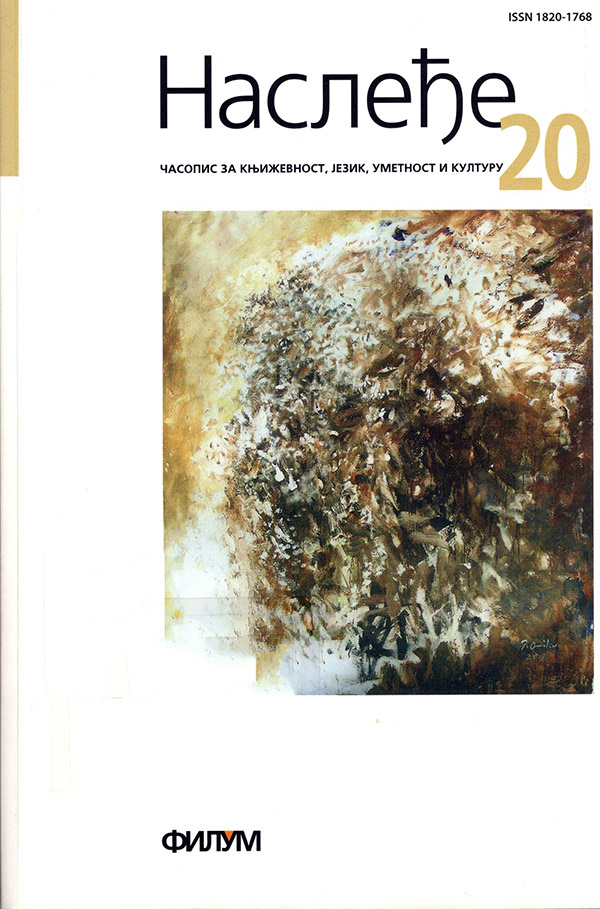ЈЕВРЕЈСКИ ИДЕНТИТЕТ У РАНОЈ МОДЕРНОЈ ЕВРОПСКОЈ ИСТОРИЈИ
Keywords:
Jews, Renaissance, identity, anti-Judaism, the image of the other, integration, mental and visual differentiation, presentation and self-presentationAbstract
Jewish identity in the early modern period – the era in which traditional anti-Judaism turned into anti-Semitism – is shaped by violence, expulsion, ghetoisation, visual forms of dirrerentiation, integration but not assimilation into the European Christian culture. Studying the relationship of intellectual and physical categories, soul and body as a social and historical construct, it can be, to some extent, answer the question what it means to be Jewish in the early modern period. Based on the experiences of actual protagonists and observers, in their own reality, this text represents the perception and self-perception of Jews in the mental and visual codes of the Renaissance.
References
Bear 2001: Y. Bear, A History of the Jews in Christian Spain, Vol. II, From the Fourteenth Century to the Expulsion, The Jewish Publication Society of America, Philadelphia.
Bere 1998: P. Bere, The Jew as Renaissance Man, Renaissance Quarterly 51/1, 128–162.
Berger 1997: D. Berger, Anti-Semitism: An Overview, in: D. Berger ed., History and Hate: The Dimensions of Anti-Semitism, Philadelphia.
Bonfil 1988: R. Bonfil, How Golden was the Age of the Renaissance in Jewish Historiography?, History and Theory (Essays in Jewish Historiography) 27/4, 78–102.
Bonfil 1994: R. Bonfil, Jewish Life in Renaissance Italy, Berkeley.
Bonfil 1994: R. Bonfil, Changing Mentalities in Italian Jews between the Periods of the Renaissance and the Baroque, Italia 11, 61–79.
Bonfil 2001: R. Bonfil, A Cultural Profile, in: R. C. Davis, B. Ravi eds., The Jews of Early Modern Venice, The John Hopkins Univ. Press, 169–190.
Брајовић 2009: С. Брајовић, Ренесансно сопство и портрет, Београд.
Burke 1991: P. Burke, The Language of Gesture in Early Modern Italy, in: J. Bremmer, H. Roodenburg eds., A Cultural History of Gesture, Ithaca and New York: Cornell Univ. Press, 71–83.
Burke 2001: P. Burke, Eyewitnessing: The Uses of Images as Historical Evidence, Ithaca, Cornell Univ. Press.
Chazen 2004: R. Chazen, The Jews of Medieval Western Christendom 1000–1500, Cambridge 2004.
Cohen 1982: J. Cohen, The Friars and the Jews: The Evolution of Medieval Antisemitism, Ithaca, Cornell Univ. Press.
Eilberg-Schwartz 1992: H. Eilberg-Schwartz, The Problem of the Body for the People of the Book, in: H. Eilberg-Schwartz ed., People of the Body: Jews and Judaism from an Embodied Perspective, Albany, State Univ. of New York, 17–46.
Friedman 1987: J. Friedman, Jewish Conversion, the Spanish Pure Blood Laws and Reformation: A Revisionist View of Racial and Religious Antisemitism, The Sixteenth Century Journal 18/1, 3–30.
George 2002: E. V. George, Conceal or Disclose? The Limits of Self-Representation in the Letters of Juan Luis Vives, in: T. Van Hondt, J. Papy eds., Self-Presentation and Social Identification. The Rhetoric and Pragmatics of Letter Writing in Early Modern Times, Leuven Univ. Press, 405–426.
Gutwirth 2009: E. Gutwirth, Jewish Bodies and Renaissance Melancholy: Culture and the City in Italy and the Ottoman Empire, in: M. Diemling, G. Veltri eds., The Jewish Body. Corporeality, Society, and Identity in the Renaissance and Early Modern Period, Leiden, Boston, 57–92.
Harrán 2008: D. Harrán, Between Exclusion and Inclusion: Jews as Portrayed in Italian Music from the Late Fifteenth to the Early Seventeenth Century, in: D. Myers, P. Reill eds., Acculturation and Its Discontents: The Jews of Italy from Early Modern to Modern Times, Univ. of Toronto Press, 72–98.
Idel 2009: M. Idel, On the Performing Body in Theosophical-Theurgical Kabbalah: Some Preliminary Remarks, in: M. Diemling, G. Veltri eds., The Jewish Body. Corporeality, Society, and Identity in the Renaissance and Early Modern Period, Leiden, Boston, 251–272.
Jestice 2007: P. G. Jestice, A Great Jewish Conspiracy? Worsening Jewish-Christian Relations and the Destruction of the Holy Sepulcher, in: M. Frassetto ed., Attitudes Toward the Jews in the Middle Ages, New York, 25–42. Kennedy 1994: W. J. Kennedy, Authorizing Petrarch, Ithaca, Cornell Univ. Press.
Klibansky, Panofsky, Saxl 1964: R. Klibansky, E. Panofsky, F. Saxl, Saturn and Melancholy: Studies in the History of Natural Philosophy, Religion, and Art, London.
Lelli, 2004: F. Lelli, Biography and Autobiography in Yohanan Alemanno’s Literary Perception, in: D. B. Ruderman, G. Veltri eds, Cultural Intermediaries: Jewish Intellectuals in Early Modern Italy, Univ. of Pennsylvania Press, 25–38.
Lesley 1992a: A. M. Lesley, The Place of the Dialoghi d’Amore in Contemporaneous Jewish Thought, in: D. B. Ruderman ed., Essential Papers on Jewish Culture in Renaissance and Baroque Italy, New York Univ. Press, 170–188.
Lesley 1992b: A. M. Lesley, Jewish Adaptation of Humanist Concepts in Fifteenth and Sixteenth-Century Italy, in: Essential Papers on Jewish Culture in Renaissance and Baroque Italy, New York Univ. Press, 45–62.
Lesley 2009: A. M. Lesley, Giving Birth to the Hebrew Author: Two Compositions by Johanan Alemanno, in: M. Diemling, G. Veltri eds., The Jewish Body. Corporeality, Society, and Identity in the Renaissance and Early Modern Period, Leiden, Boston, 273–300.
Miletto 2009: G. Miletto, The Human Body as a Musical Instrument in the Sermons of Judah Moscato, in: M. Diemling, G. Veltri eds., The Jewish Body. Corporeality, Society, and Identity in the Renaissance and Early Modern Period, Leiden, Boston, 377–394.
Mirandola 1994: Đ. Piko dela Mirandola, Govor o dostojanstvu čovekovu, prevod, uvod i napomene S. Gudžević, Beograd.
Nirenberg 2002: D. Nirenberg, Mass Conversion and Genealogical Mentalities: Jews and Christians in 15th Spain, Past & Present 174, 3–41.
Nochlin 1995: L. Nochlin, Starting with the Self: Jewish Identity and Its Representation, in: L. Nochlin, T. Garb eds., The Jew in the Text: Modernity and the Construction of Identity, London, 7–19.
Oberman 1984: H. Oberman, The Roots of Anti-Semitism in the Ages of the Renaissance and Reformation, Philadelphia.
Owen Huges 1986: D. Owen Huges, Distinguishing Signs: Ear-Rings, Jews and Franciscan Rhetoric in the Italian Renaissance”, Past & Present 112, 3–59. Porter 1991: R. Porter, History of the Body, in: P. Burke ed., New Perspectives on Historical Writing, Cambridge, 206–232.
Pullan 1997: B. Pullan, The Jews of Europe and the Inquisition of Venice, 1550–1670, London.
Rietes 1981: J. W. Rietes S.J., St. Ignatius Loyola and the Jews, Studies in the Spirituality of Jesuits 13/4, 17–45.
Rowan 1985: S. Rowan, Luther, Bucer, and Eck on the Jews, The Sixteenth Century Journal 16/1, 79–90.
Shear 2004: A. Shear, Judah Moscato’s Scholarly Self-Image and the Question of Jewish Humanism, in: D. B. Ruderman, G. Veltri eds, Cultural Intermediaries: Jewish Intellectuals in Early Modern Italy, Univ. of Pennsylvania Press, 149–177.
Shulvass 1985: M. A. Shulvass, The History of the Jewish People, Chicago. Simon 1991: M. Simon, Christian Anti-Semitism, in: J. Cohen ed., Essential Papers on Judaism and Christianity in Conflict: From Late Antiquity to the Reformation, New York Univ. Press, 131–173.
Simonsohn 1996: S. Simonsohn, Giovanni Pico della Mirandola on Jews and Judaism, in: J. Cohen ed., From Witness to Witchcraft: Jews and Judaism in Medieval Christian Thought, Wiesbaden, 403–417.
Simonsohn 1991: S. Simonsohn, The Apostolic See and the Jews, Toronto. Soufas 1990: T. Scott Soufas, Melancholy and the Secular Mind in Spanish Golden Age Literature, Columbia-London 1990.
Ultsch 2000: L. J. Ultsch, Sara Copio Sullam: A Jewish Woman of Letters in 17th-Century Venice, Italian Culture 18, 73–86.
eltri 2004: G. Veltri, Philo and Sophia: Leone Ebreo’s Concept of Jewish Philosophy, in: D. B. Ruderman, G. Veltri eds, Cultural Intermediaries: Jewish Intellectuals in Early Modern Italy, Univ. of Pennsylvania Press, 55–66.
Veltri 2009: G. Veltri, Body of Conversion and the Immortality of the Soul: The Beautiful Jewess Sara Copio Sullam, in: M. Diemling, G. Veltri eds., The Jewish Body. Corporeality, Society, and Identity in the Renaissance and Early Modern Period, Leiden, Boston, 331–354.
Weinstein 2009: R. Weinstein, The Body in Historical and Social Context. The Rise of the Body in Early Modern Jewish Society: The Italian Case Study, in: M. Diemling, G. Veltri eds., The Jewish Body. Corporeality, Society, and Identity in the Renaissance and Early Modern Period, Leiden, Boston, 15–56.
Zinberg 1974: I. Zinberg, A History of Jewish Literature. Italian Jewry in the Renaissance Era, New York.






